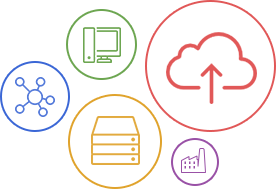Imagine waking up to frantic calls that your company’s confidential data has just gone public. No one expects it, yet it happens far too often. According to IBM’s 2024 Cost of a Data Breach Report, the average data breach now costs $4.88 million.
|
“True cloud security starts with the belief that no system is safe until it’s tested, monitored, and continually refined.” - Emil Isanov, CEO and Founder of ETech 7 |
Business owners who underestimate cloud security often invite irreversible damage to their digital operations.
That’s a price small and mid-sized businesses simply can’t afford. You want to leverage the cloud’s flexibility and scalability, but the fear of a crippling breach is real. Let’s uncover why these breaches happen—and more importantly, how you can stop them.
The Real Price of Cloud Vulnerabilities
When hackers strike, the damage goes beyond downtime. There’s the cost of repairing systems, potential lawsuits, lost customer trust, and lost revenue.
Even a few hours of compromised systems can set your business back weeks. According to CloudSecureTech, over 60% of small companies fail within six months of a severe cyberattack. That’s an eye-opener that cloud security threats are neither abstract nor distant; they’re immediate dangers that can obliterate your hard-earned success.
Ignoring regular updates and audits is like leaving your front door unlocked in a high-crime neighbourhood. It’s a risk no one should willingly take.
The 8 Types of Cloud Security Threats
Complex cloud environments create multiple entry points for attackers. Whether it’s sophisticated malware, ransomware that locks your data, or opportunistic phishing scams, these security threats in cloud computing exploit weak links in a hurry.
According to the Cloud Security Alliance, many of these threats stem from misconfiguration and inadequate security controls. One overlooked configuration error can lead to massive breaches. Insider threats, either malicious or accidental, also compound the problem.
Let’s dive deeper into the most formidable cloud computing security threats lurking out there:
1. Ransomware
Ransomware is an especially insidious form of malware that encrypts your data and demands payment to restore it. In the cloud, this can spread more rapidly because files are often synced across multiple users and devices. Attackers capitalize on unpatched vulnerabilities and out-of-date software to gain entry. Once inside, they can lock up vast swaths of data in minutes.
2. Phishing Attacks
Phishing tactics trick employees into divulging usernames and passwords. According to Verizon’s 2024 Data Breach Investigations Report, phishing was linked to over 80% of reported security incidents, making it a prime culprit for credential theft. It just takes one successful phishing email to hand an attacker the keys to your cloud environment.
3. Insider Threats
Employees, whether disgruntled or just careless, can unintentionally (or deliberately) hand over your data to unauthorized parties. This could either be clicking on malicious links or downloading confidential files on personal devices, human missteps are often the weakest link. The IBM X-Force Threat Intelligence Index has repeatedly flagged insiders as a top concern, emphasizing the need for robust monitoring and strict access policies.
4. Misconfiguration
A small oversight in setting up storage buckets, virtual machines, or identity policies can lead to a wide-open back door for hackers. Researchers at Check Point have identified that misconfiguration is one of the primary drivers of cloud data breaches. Overly permissive access, unencrypted databases, and default credentials are red flags you should eliminate ASAP.
Strengthen Your Cloud Defenses to Avoid Costly Data Breaches!
5. Distributed Denial of Service (DDoS)
DDoS attacks flood your infrastructure with bogus requests, rendering services inaccessible to legitimate users. In a cloud environment, this can disrupt an entire organization’s operation and prevent employees and customers from accessing data. While major cloud providers offer built-in DDoS mitigation, you’re still responsible for configuring and monitoring these safeguards.
6. Advanced Persistent Threats (APTs)
APTs target high-value data by infiltrating systems and staying hidden for months or even years. They often use sophisticated techniques like privilege escalation and lateral movement to harvest confidential data. When it comes to cloud computing security threats, APTs are particularly dangerous because they blend in with normal traffic and exploit vulnerabilities that many organizations fail to detect promptly.
7. API Vulnerabilities
Cloud services rely heavily on APIs for communication. If an attacker exploits a poorly secured API, they can manipulate data flows or gain unauthorized access to backend systems. Thorough API testing and robust authentication methods, such as OAuth 2.0, are critical to ensuring that your APIs don’t become an open invitation to your cloud infrastructure.
8. Shared Technology Exploits
The cloud computing space is multi-tenant, various customers share the same infrastructure. If the underlying hypervisor, container platform, or hardware layer is compromised, it can affect multiple tenants simultaneously. While providers typically isolate tenants effectively, new vulnerabilities do emerge.
This shared-risk model demands proactive measures, including regular patch management and provider diligence, to avoid becoming collateral damage.
Hot Tip: Don’t assume attackers will try only one method at a time. Many orchestrate layered approaches—like combining a phishing email with a misconfiguration exploit— to ensure they have multiple ways to breach your defenses.

Future-Proof Methods to Combat Cloud Security Threats
Saying you’ll deal with cloud computing security threats “later” is like ignoring a slow leak in your roof: eventually, the ceiling collapses. Protecting your cloud ecosystem starts with the right technology stack and a proactive strategy. Consider Zero Trust architecture, which assumes no device or user is automatically trustworthy—even inside your network.
Core Defense Measures:
- Encryption Everywhere: Encrypt data at rest and in transit.
- Multi-Factor Authentication (MFA): Strengthen login processes beyond a single password.
- Identity Access Management (IAM): Fine-tune who can access what, and monitor all account usage.
- Continuous Monitoring: Use automated systems to detect and respond to anomalies.
|
For More Insights on Gaining Long-Term Benefits From Your IT, Read Our Blog! |
Actionable Strategies to Fix Cloud Security Gaps Now
Waiting for a crisis is not an option. Here are immediate steps you can implement:
- Comprehensive Risk Assessment: Map out what data you hold, where it’s stored, and who has access to it. Then eliminate or reduce any unnecessary permissions.
- NIST’s Cybersecurity Framework provides an excellent starting point for structured risk assessments.
- Vendor Due Diligence: Vet your cloud providers’ security measures, track record, and compliance certifications. If the vendor can’t articulate how they safeguard your data, consider alternative options.
- Robust Backup Strategy: A well-executed backup plan can mean the difference between a minor setback and a permanent disaster.
- Regular Audits and Testing: Conduct penetration testing or hire third parties for unbiased security reviews.
- Policy Enforcement: Draft clear usage policies for employees—especially regarding BYOD (Bring Your Own Device).
Neglecting consistent enforcement of security policies is like having a top-notch alarm system but never switching it on. You leave the door open for opportunistic threats.
Avoiding Common Pitfalls
Even if you think your cloud is secure, slip-ups happen. One classic error is assuming the cloud provider handles all security for you. While providers handle infrastructure-level protection, your data and access configurations remain your responsibility.
Another mistake is ignoring routine updates—hackers often exploit known vulnerabilities in outdated software.
Check out this CISA guide for practical tips on keeping your systems up to date and avoiding common missteps. Ultimately, vigilance is your biggest ally in the fight against infiltration.
Key Summary Table
|
Security Strategy |
What It Does |
Key Benefit |
|
Encryption (Data at Rest & In Transit) |
Scrambles data so unauthorized users can’t read it |
Protects sensitive info from eavesdroppers |
|
Multi-Factor Authentication (MFA) |
Requires additional proof of identity (code, token, etc.) |
Greatly reduces risk of credential-based breaches |
|
Zero Trust Architecture |
Verifies every user/device interaction, no default trust |
Minimizes lateral movement within network |
|
Vendor Due Diligence |
Assesses cloud provider’s security posture and compliance |
Ensures alignment with your security and legal requirements |
|
Regular Penetration Testing |
Simulates attacks to find and fix vulnerabilities |
Proactive approach to plugging security gaps |
Contact ETech 7 for a Winning Cloud Security Plan
Cloud security threats aren’t theoretical; they’re real, fast-evolving dangers that can derail your business. You’ve learned how security missteps and human factors can create cracks in your defenses, but you’ve also discovered proven strategies—from encryption and MFA to Zero Trust—to stay ahead of attackers.
That’s where ETech 7 shines. As a leading Managed Service Provider offering comprehensive cloud solutions, ETech 7 stands ready to fortify your infrastructure, ensure compliance, and deliver peace of mind.
Contact ETech 7 today for more information and to schedule a consultation. Strengthen your cloud defenses before the next threat becomes your biggest nightmare.
|
Find The Cloud Consultants You Need in NYC! |
|














